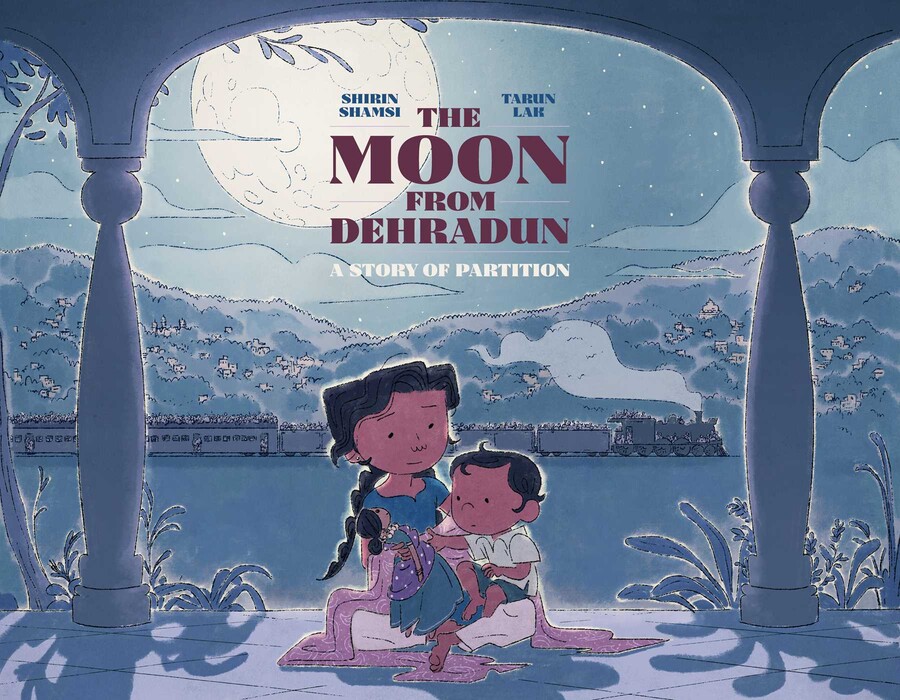 The Moon from Dehradun: A Story of Partition
The Moon from Dehradun: A Story of Partition
Written by Shirin Shamsi
Illustrated by Tarun Lak
Atheneum Books for Young Readers, 2022, 40 pp (unpaged)
ISBN: 9781665906791
Set in 1947 joint India, The Moon from Dehradun is the story of Azra, a young girl who, along with her family, is forced to flee at a moment’s notice when external foreign forces and internal unrest make living in that specific region impossible. Dehradun (a region in present-day India) has been home to her family for generations. They love their home, know no other place to call home, and live peacefully with their neighbors. Azra loves her doll ‘gurya’ (made by her grandmother) very much and does not appreciate her younger brother who is a nuisance. The book begins with Azra telling her doll that they must leave in five days. Following the decision of Britain to divide the country up according to majority religion, bloody riots break out.
Azra’s family are Muslims but live in a majority Hindu area. They know that they will have to move to the area that will be Pakistan (a majority Muslim nation). Their move suddenly becomes rushed as their own neighbors come to attack them. The family leaves without taking anything except a few belongings. What is also left behind, in their hurry, is Azra’s beloved ‘gurya.’ They travel night and day and feel sadness as a country and a people break into pieces. The harrowing train journey is captured very well in the visual text/illustrations by Lak. They reach Pakistan and are given a home to stay in because their papers check out. When they enter their new home, it looks like a family had also left there in a hurry. In checking out her surroundings, Azra finds a forlorn ‘gurya’ left under the bed. The story goes full circle on the second to last spread when another anonymous family with a little girl enters Azra’s home in Dehradun only to find ‘gurya.’ The last spread shows both girls holding their ‘guryas,’ separated by distance but joined by a shared tumultuous experience.
This book relates to an oft forgotten history of the British colony and the hasty partition that created the individual countries of India and Pakistan in 1947. The story is inspired by Shamsi’s own family’s journey from India to Pakistan. She draws on her memories of tales told to her from first person accounts that lend credibility to the text. The book also includes notes, maps, and an author’s note to situate the reader contextually. This is a powerful story which speaks to the powers that manipulated peoples indigenous to the land by dissecting the land haphazardly and forcing their movement. This story concludes with a message of understanding and peace that is accessible to younger audiences.
Lak does an excellent job of visually representing the chaos during the actual physical partition. There are many photographs available online that authenticate his digital illustrations. He recreates the chaos characters feel through the tangible depiction of dust, the harassed expressions of the characters, and the backdrops of millions of people on the move.
While many books speak to the themes of immigration and forced journeys, another book that is set in the same region and historical forced movement is Veera Hiranandani’s (2018) The Night Diary where readers get the perspective in reverse. A Hindu family must move from the area designated as Pakistan to Indian regions and the story describes their harrowing experiences. Hiranandani’s book is a novel in verse where a young girl is writing a diary to her dead mother who was a Muslim married to a Hindu doctor. Both the books speak to the concerns of trauma for young children when it comes to seeing bloodshed and leaving all that is familiar. Other strong narratives that speak to the same premise are Inside Out and Back Again by Thanhhà Lai (2011), The War That Saved My Life by Kimberly Brubaker Bradley (2015), Escape from Aleppo by N. H. Senzai (2018), Other Words for Home by Jasmine Warga (2019) and the more recent Ida in the Middle by Nora Lester Murad (2022). In this last book Murad brings a Palestinian perspective, important to the present day forced movement in Gaza.
Shirin Shamsi was born and raised in the U.K. and now resides in the U.S. She has lived on three continents and sees herself as a global citizen. She shares stories from her life and culture, and in doing so she strives to inspire an appreciation for diversity. She is a member of SCBWI. Shirin is the author of multiple books that include the picturebook Zahra’s Blessing: A Ramadan Story (2022), and a novel Laila and the Sands of Time (2019). She also has an interfaith collaboration in Planting Friendship (2021) and educational works in The Girl Who Dared (2019), Nani’s Birthday Surprise (2021), and Civic Duty (2021), to name a few. All her books have a message of acceptance and are balanced in the representations of diverse cultures.
The illustrator, Tarun Lak, belongs to the Indian American community with his family hailing from Chennai, India. He was born in Miami and raised in Chennai. He attended Ringling College of Art and Design to study computer animation. He has worked on renowned animations such as Spiderman: Into Spider-verse and Soul and Luca. He currently lives in San Francisco. This is his first picturebook.
Seemi Aziz-Raina, University of Arizona
© 2024 by Seemi Aziz-Raina

WOW Review, Volume XVI, Issue 3 by Worlds of Words is licensed under a Creative Commons Attribution-NonCommercial-ShareAlike 4.0 International License. Based on work by Seemi Aziz-Raina at https://wowlit.org/on-line-publications/review/xvi-3/8/
WOW review: reading across cultures
ISSN 2577-0527
